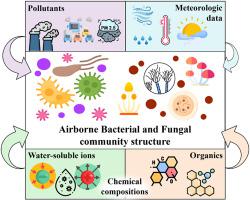当前位置:
X-MOL 学术
›
Environ. Pollut.
›
论文详情
Our official English website, www.x-mol.net, welcomes your feedback! (Note: you will need to create a separate account there.)
Implications of PM2.5 chemical composition in modulating microbial community dynamics during spring in Seoul
Environmental Pollution ( IF 8.9 ) Pub Date : 2024-03-20 , DOI: 10.1016/j.envpol.2024.123834 Sookyung Kang , Ji Yi Lee , Kyung-Suk Cho
Environmental Pollution ( IF 8.9 ) Pub Date : 2024-03-20 , DOI: 10.1016/j.envpol.2024.123834 Sookyung Kang , Ji Yi Lee , Kyung-Suk Cho

|
Particulate matter with an aerodynamic diameter of 2.5 μm or less (PM) harbors a diverse microbial community. To assess the ecological dynamics and potential health risks associated with airborne microorganisms, it is crucial to understand the factors influencing microbial communities within PM. This study investigated the influence of abiotic parameters, including air pollutants, PM chemical composition (water-soluble ions and organics), and meteorological variables, on microbial communities in PM samples collected in Seoul during the spring season. Results revealed a significant correlation between air pollutants and water-soluble ions of PM with microbial α-diversity indices. Additionally, air pollutants exerted a dominant effect on the microbial community structure, with stronger correlations observed for fungi than bacteria, whereas meteorological variables including temperature, pressure, wind speed, and humidity exerted a limited influence on fungal α-diversity. Furthermore, the results revealed specific water-soluble ions, such as SO, NO, and NH, as important factors influencing fungal α-diversity, whereas K negatively correlated with both microbial α-diversity. Moreover, PM microbial diversity was affected by organic compounds within PM, with fatty acids exhibited a positive correlation with fungal diversity, while dicarboxylic acids exhibited a negative correlation with it. Furthermore, network analysis revealed direct links between air pollutants and dominant bacterial and fungal genera. The air pollutants exhibited a strong correlation with bacterial genera, such as and , and fungal genera, including and . These results will contribute to our understanding of the ecological dynamics of airborne microorganisms and provide insights into the potential risks associated with PM exposure.
中文翻译:

PM2.5 化学成分对调节首尔春季微生物群落动态的影响
空气动力学直径为 2.5 μm 或更小的颗粒物 (PM) 蕴藏着多样化的微生物群落。为了评估与空气微生物相关的生态动态和潜在健康风险,了解影响 PM 内微生物群落的因素至关重要。本研究调查了非生物参数,包括空气污染物、PM 化学成分(水溶性离子和有机物)和气象变量,对春季在首尔收集的 PM 样品中微生物群落的影响。结果表明,空气污染物和 PM 水溶性离子与微生物 α 多样性指数之间存在显着相关性。此外,空气污染物对微生物群落结构产生主导影响,真菌的相关性强于细菌,而温度、压力、风速和湿度等气象变量对真菌α多样性的影响有限。此外,结果表明特定的水溶性离子,如 SO、NO 和 NH,是影响真菌 α 多样性的重要因素,而 K 与微生物 α 多样性呈负相关。此外,PM微生物多样性受到PM中有机化合物的影响,脂肪酸与真菌多样性呈正相关,而二羧酸与真菌多样性呈负相关。此外,网络分析揭示了空气污染物与优势细菌和真菌属之间的直接联系。空气污染物与细菌属(如 和 )以及真菌属(包括 和 )表现出很强的相关性。这些结果将有助于我们了解空气中微生物的生态动态,并深入了解与 PM 暴露相关的潜在风险。
更新日期:2024-03-20
中文翻译:

PM2.5 化学成分对调节首尔春季微生物群落动态的影响
空气动力学直径为 2.5 μm 或更小的颗粒物 (PM) 蕴藏着多样化的微生物群落。为了评估与空气微生物相关的生态动态和潜在健康风险,了解影响 PM 内微生物群落的因素至关重要。本研究调查了非生物参数,包括空气污染物、PM 化学成分(水溶性离子和有机物)和气象变量,对春季在首尔收集的 PM 样品中微生物群落的影响。结果表明,空气污染物和 PM 水溶性离子与微生物 α 多样性指数之间存在显着相关性。此外,空气污染物对微生物群落结构产生主导影响,真菌的相关性强于细菌,而温度、压力、风速和湿度等气象变量对真菌α多样性的影响有限。此外,结果表明特定的水溶性离子,如 SO、NO 和 NH,是影响真菌 α 多样性的重要因素,而 K 与微生物 α 多样性呈负相关。此外,PM微生物多样性受到PM中有机化合物的影响,脂肪酸与真菌多样性呈正相关,而二羧酸与真菌多样性呈负相关。此外,网络分析揭示了空气污染物与优势细菌和真菌属之间的直接联系。空气污染物与细菌属(如 和 )以及真菌属(包括 和 )表现出很强的相关性。这些结果将有助于我们了解空气中微生物的生态动态,并深入了解与 PM 暴露相关的潜在风险。



























 京公网安备 11010802027423号
京公网安备 11010802027423号